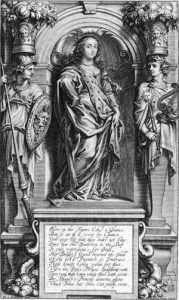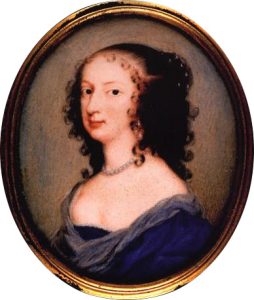22 “A Posset for Nature’s Breakfast” (1653)
With an Introduction by Kaitlyn Hess
Margaret Cavendish
Introduction

The text on the plaque below Cavendish reads: “Here on this figure cast a glance, but so as it were by chance, your eyes not fixed, they must not stay, since this like shadows to the day it only represents; for still, her beauty’s found beyond the skill of the best painter, to embrace, those lovely lines within her face, view her soul’s picture, judgment, wit, then read those lines which she hath writt, by fancy’s pencil drawn alone which peace but she can justly own.”
Margaret Cavendish, Duchess of Newcastle upon Tyne, was a writer ahead of her time. She was born near Colchester, Essex, England around 1623 to a gentry family. In her 1656 autobiography, A True Relation of My Birth, Breeding and Life, Cavendish describes how her mother, Elizabeth Leighton, showed her how a woman should act as head of a household, as she stepped into the role following the death of Margaret’s father. She describes herself as quite a meek and mild person. Her meekness was not weakness. Around the age of twenty, Cavendish became a lady-in-waiting for Queen Henrietta Maria and followed her to Paris when she was exiled. It was here that she met her future betrothed, William Cavendish, Marquess of Newcastle upon Tyne (Fitzmaurice). He liked her bashfulness and supported her in her thoughts and writings. William was a widower about thirty years her senior. This courtship was not taken well by many, and Queen Henrietta Maria herself was against it. Despite this, Margaret and William were married in late 1645. Despite the help of doctors, the couple was not able to conceive, though William did have five children from his previous marriage. They also had financial difficulties connected to the ongoing English Civil Wars.
During this time, Cavendish wrote the first edition of Poems and Fancies (Margaret Cavendish, Duchess of Newcastle-Upon-Tyne). Poems and Fancies is a headfirst dive into Cavendish’s innermost philosophical thoughts. Its contents include poems and prose about atomic theory, natural philosophy, gender, and domesticity. Her writings proved to be very influential and made her stand out during her lifetime.
Cavendish’s poem “A Posset for Nature’s Breakfast” was published in this volume. At first glance, this poem reads like a recipe for a posset. Upon further inspection, it’s apparent that Cavendish wrote this with women and housewives specifically in mind (Snively 5). In a time when being a housewife was the expected job of many women, Cavendish writes in a language these women would have found familiar. “A Posset for Nature’s Breakfast” is written just like a recipe would be at the time, which the average woman could read with ease, and personifies Life as a housewife creating a posset for Mother Nature. By doing this, Cavendish not only utilizes the “practical, experiential knowledge” of the women she’s writing to but also draws parallels between women and God (Snively 5). This poem can be explored as a piece of queer poetry because Cavendish makes Life the housewife of Mother Nature. “A Posset for Nature’s Breakfast” can be interpreted as a love letter to women and their relationship with domesticity, food, medicine, sexuality, nature, and God. Cavendish wrote to the women in her audience as intelligent individuals at a time when women’s knowledge was undervalued and underestimated.

“A Posset[1] for Nature’s Breakfast”
Life scums the cream of beauty with time’s spoon,
And draws the claret wine of blushes soon.
Then boils it in a skillet clean of youth,
And thicks it well with crumbled bread of truth,
And sets it on the fire of life[2], which does
Burn clearer much when health her bellows blows[3].
Then takes the eggs of fair and bashful eyes,
And puts them in a countenance that’s wise,
And cuts a lemon in of sharpest wit;
Discretion, as a knife, is used for it.
A handful of chaste thoughts double refined,
Six spoonfuls of a nobl’and gentle mind,
A grain of mirth, to give’t a little taste,
Then takes it off, for fear the substance waste,
And puts it in a basin of good health,
And with this meat doth Nature please herself[4].
Sources:
“A Posset for Nature’s Breakfast” edited by Liza Blake from Margaret Cavendish’s Poems and Fancies licensed by CC BY-NC
“bellows, n., sense 1.b”. Oxford English Dictionary, OUP, July 2023, doi.org/10.1093/OED/1745228863
“posset, n., sense 1.” Oxford English Dictionary, OUP, Sept. 2023, doi.org/10.1093/OED/1044187210
“What Does the Bible Say about Breath?” Openbible.info, 2023, openbible.info/topics/breath.
“What Does the Bible Say about Fire?” Openbible.info, 2023, openbible.info/topics/fire.
Citations:
Cavendish, Margaret. “A Posset for Nature’s Breakfast.” Transatlantic Literature and Premodern Worlds, edited by Marissa Nicosia, et al., Pressbooks, 2025.
Hess, Kaitlyn. Introduction to “A Posset for Nature’s Breakfast.” Transatlantic Literature and Premodern Worlds, edited by Marissa Nicosia, et al., Pressbooks, 2025.
- Margaret Cavendish structures this poem as a recipe for a posset. A posset during Cavendish’s time was a medicinal drink made from heated milk, some type of alcohol for curdling, sugar, herbs, spices, and other ingredients depending on the recipe (OED). A medicinal drink like this was an intentional choice for Cavendish to make. Housewives played a huge, underrated role in their families’ lives and a large part of that role was being a caretaker and tending to those who were sick. Cavendish references this by having the housewife, personified as Life, create a posset. The choice to use a posset could also be a nod to her scientific interests, as cooking and medicine are considered scientific (Snively 7-8). She had a talent for blending her knowledge of womanhood with her knowledge of science. By making Life serve this medicinal posset to Mother Nature, Cavendish could also be making a statement about how we should be taking care of nature. Other references later in the poem suggest the best way to please Mother Nature would be to live a happy, fulfilling life. ↵
- Since a posset requires heat, Cavendish describes Life creating the posset with “the fire of life.” This could be taken literally, but it could also reference fire in a biblical sense. Since she came from a religious background, it would be fitting for Cavendish to be using fire in this way. Fire has long symbolized a form of cleansing, purification, and even a manifestation of God (“What does the Bible Say about Fire?”). “The fire of life” could be a reference for all three of those, but the manifestation of God feels the most fitting considering the context given. Life is also one of the (arguably) two main characters in this poem, so “fire of life” could be directly referencing the same “Life.” Although Cavendish does make a distinction between the two by capitalizing the “L” in Life, the character, and making it lowercase in “life.” Either way, she makes the connection that Life is also God, giving life to this “posset” which could also be interpreted as Life creating a person to satisfy Mother Nature. ↵
- The next line supports the idea that Cavendish draws on biblical themes with the phrase “her bellows blows.” The breath of life is a well-known and recurring idea from the Bible which is interpreted as God giving life to mankind (“What does the Bible say about Breath?”). A bellow is also a tool made of a bag and a box, which fills with air and then blows it out to help a fire grow or burn greater (OED). In this phrase, Life is both the cook and the tool being used for the fire, blowing to make it burn clearer and to give it life. This transference takes place so Life can create what Mother Nature craves: a living, breathing, human being. It can also be thought that by blowing on the fire, maybe Life is also giving this dish/person more life experience, making them more flavorful. The housewife Life then refines them making the dish/person more to Mother Nature’s taste. ↵
- a. Cavendish ends her poem as strongly as she started. After creating a delicious, well-rounded person, Life serves this up to Mother Nature and she wholeheartedly enjoys the fruits of Life’s labor. The pleasure Mother Nature feels could mean she is appreciating the time it takes to create a life this delicious. In previous lines, Life gives this person traits of mirth, bashfulness, and a gentle mind, showing that this is not a rushed dish, but one carefully put together by a skilled cook. This could also be seen as a sensual form of pleasure. Pleasuring herself with this human who was made by her housewife, Life, Mother Nature’s actions spark thoughts of sensual pleasure as the two can be read as spouses or sexual partners. This is not the only instance in which Cavendish has written a potentially queer character. In her play The Lady Contemplation, she gave her story a “lesbian twist” (Robinson 133). The phrase “doth Nature please herself” could also be viewed as a cannibalistic form of pleasure. Life and Mother Nature could be considered one and the same, with human life being a part of that. So, is Mother Nature also the cook? Is she her own housewife? Could she be the meat she is consuming? And finally, is she deriving pleasure by herself? ↵

